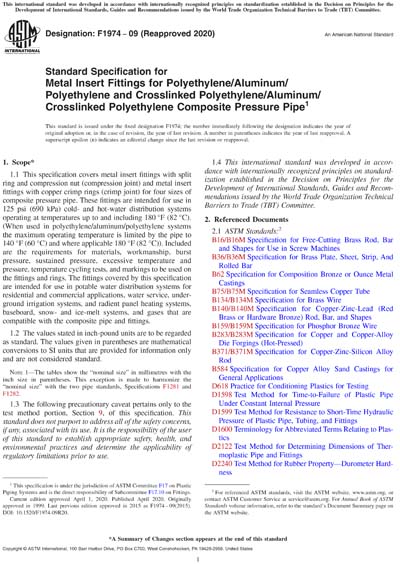Historical
ASTM F1974-09(2020)
Standard Specification for Metal Insert Fittings for Polyethylene/Aluminum/Polyethylene and Crosslinked Polyethylene/Aluminum/Crosslinked Polyethylene Composite Pressure Pipe
1.1 This specification covers metal insert fittings with split ring and compression nut (compression joint) and metal insert fittings with copper crimp rings (crimp joint) for four sizes of composite pressure pipe. These fittings are intended for use in 125 psi (690 kPa) cold- and hot-water distribution systems operating at temperatures up to and including 180 °F (82 °C). (When used in polyethylene/aluminum/polyethylene systems the maximum operating temperature is limited by the pipe to 140 °F (60 °C) and where applicable 180 °F (82 °C)). Included are the requirements for materials, workmanship, burst pressure, sustained pressure, excessive temperature and pressure, temperature cycling tests, and markings to be used on the fittings and rings. The fittings covered by this specification are intended for use in potable water distribution systems for residential and commercial applications, water service, underground irrigation systems, and radient panel heating systems, baseboard, snow- and ice-melt systems, and gases that are compatible with the composite pipe and fittings.
1.2 The values stated in inch-pound units are to be regarded as standard. The values given in parentheses are mathematical conversions to SI units that are provided for information only and are not considered standard.
Note 1: The tables show the “nominal size” in millimetres with the inch size in parentheses. This exception is made to harmonize the “nominal size” with the two pipe standards, Specifications F1281 and F1282.
1.3 The following precautionary caveat pertains only to the test method portion, Section 9, of this specification. This standard does not purport to address all of the safety concerns, if any, associated with its use. It is the responsibility of the user of this standard to establish appropriate safety, health, and environmental practices and determine the applicability of regulatory limitations prior to use.
1.4 This international standard was developed in accordance with internationally recognized principles on standardization established in the Decision on Principles for the Development of International Standards, Guides and Recommendations issued by the World Trade Organization Technical Barriers to Trade (TBT) Committee.
Content Provider
ASTM International [astm]






